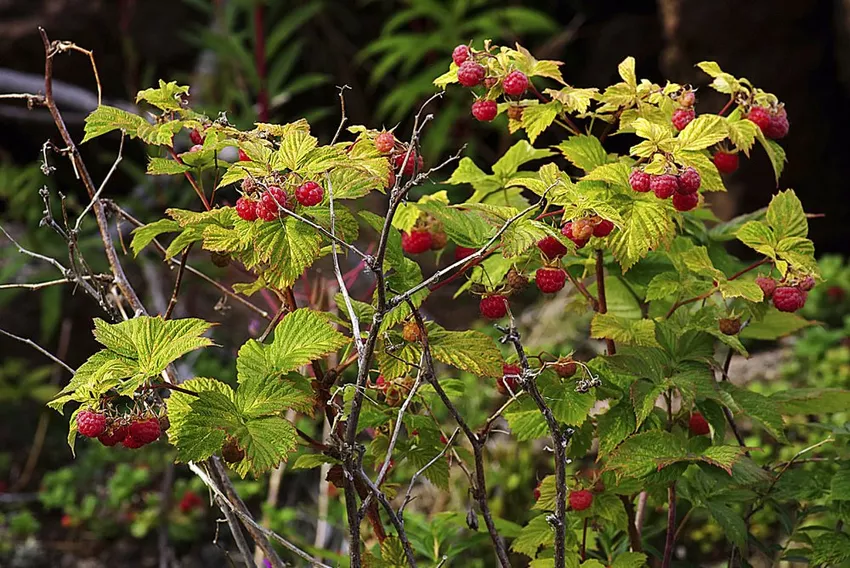For a rich raspberry harvest you sometimes have to use scissors. We will show you the differences between pruning summer and autumn varieties.

Raspberries are not only totally delicious and refresh us in summer with their sweet and sour taste. They are still very he althy. So it's no wonder that more and more hobby gardeners are getting this power fruit into their garden. However, in order for the plants to produce a bountiful harvest every year, they have to be cut twice a year.
Raspberry Varieties
When and how to cut your raspberries depends on whether they are a summer or autumn variety. Summer varieties include all raspberries whose fruits are ready to be harvested in summer. Consequently, all raspberries that you can harvest in autumn are fall varieties.
With the summer varieties, only the shoots from the previous year bear fruit. The autumn raspberries, on the other hand, produce their fruit on the shoots from the current calendar year.Tip: Twotimer raspberries bear fruit twice a year. Each shoot bears fruit for the first time as a young shoot in autumn and a second time in the summer of the following year. They are pruned in the same way as the summer varieties.
Pruning after harvest
For both varieties, the shoots should be cut off just above the ground immediately after harvest. This is how you can prevent the so-called raspberry cane disease.
You don't need to pay much attention to pruning the autumn raspberries. After harvesting in autumn, simply cut off all shoots close to the ground. With a flat layer of leaves you protect the shallow root system from frost and drying out.
Tip: Leave isolated he althy shoots. These serve as winter quarters for beneficial insects such as the predatory beetle, so that they can become active again directly in the coming year.
Pruning summer raspberries is a little more complicated. Here you need to distinguish between old and new shoots. The shoots from the previous year that have borne fruit in the current calendar year must be cut off close to the ground.
Hint: When you get the last raspberryharvest, it is best to remove the corresponding shoot immediately. That way you don't confuse the old shoots with the new shoots.
The young shoots will bear fruit next summer. So that they can grow more luxuriantly, you should leave a maximum of ten plants per meter.
Pruning for a better yield

Raspberries sometimes form quite a lot of side shoots, so the fruits may not get enough light. This could result in the fruit being smaller and even less sweet. It also promotes fungal diseases. For these reasons, the shoots may need to be thinned out. Here it is important to differentiate between the summer and autumn varieties.
Tip: You can ensure a better yield when planting. Read our article "Raspberries - more yield through proper planting".
Pruning for summer raspberries
After the last frost - around the end of February - you should take a close look at the shoots that you left last year and see if you have to remove any side shoots. Keep in mind that fewer side shoots mean fewer fruits, but stronger and tastier raspberries.
Tip: First cut off the side shoots that are difficult to reach. These are usually the lowest branches. You can also shorten the rods in height so that you can harvest the fruit there without too much effort.
If you have thinned out the shoots, you should loosely attach them to a trellis at a height of 30, 100 and 180 centimeters. This will prevent the plant from tipping over under the weight of the fruit.
Pruning for autumn raspberries
When the summer starts, you should also make a training cut for the autumn raspberries. Since you are only dealing with young shoots here, you can leave between 15 and 20 rods per meter and cut the remaining rods close to the ground. With the remaining shoots, make sure that they do not constrict each other and, if necessary, shorten the side shoots here as well.
Tip: A support frame about 80 to 100 centimeters high ensures that the plants do not fall over later under the weight of the fruit.
Care cut possible at any time
Check your raspberry plants regularly. So you can intervene immediately if you have diseased or pest-infested shootsdiscover. If you do not remove these immediately, they can also infect other shoots.
You should also make sure that the raspberries don't sprout too much. Both too dense and too high growth is not exactly beneficial. Therefore, make suitable cutting measures between the development cut and the pruning. Make sure, however, that you do not shorten the shoots during flowering.